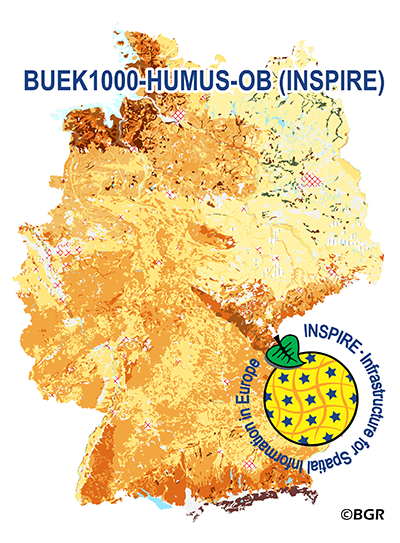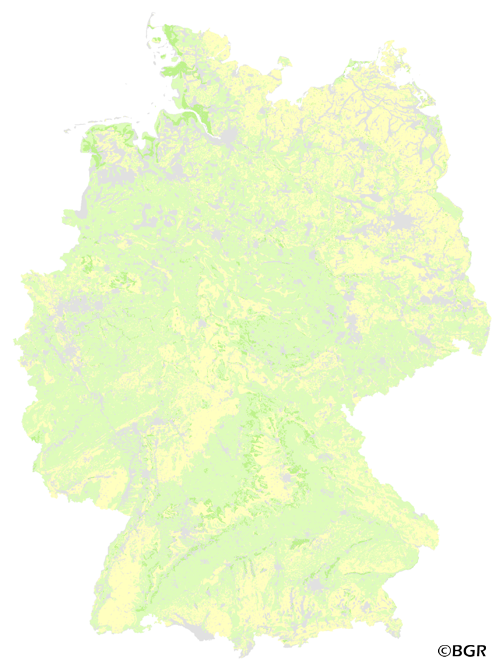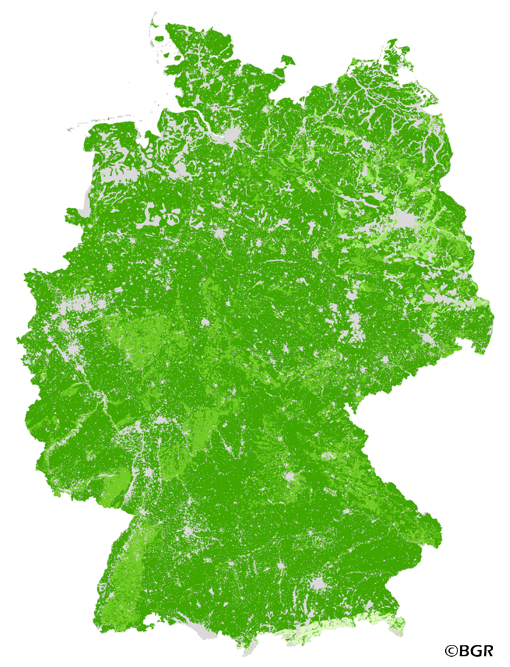Keyword
Bodenprozess
7 record(s)
Provided by
Type of resources
Available actions
Topics
Keywords
Contact for the resource
Service types
-

The WMS of the map „Organic Matter Content of Top-Soils in Germany 1:1,000,000 (INSPIRE)“ highlights the results of a Germany-wide compilation of typical soil organic matter contents in top-soils differentiated according to groups of soil parent material, four climatic areas and the main land use. The evaluation is based on more than 9000 soil data profiles with information about Soil Organic Matter (SOM) from a period of about 20 years. The report 'The Organic Matter Content of Top-Soils in Germany', BGR Archive, No. 0127036 (in German) documents the methodology. To transform the organic matter content (of the original dataset HUMUS1000OB) into INSPIRE-relevant organic carbon content (CORG), we applied the van Bemmelen factor (1.724). According to the “Data Specification on Soil“ (D2.8.III.3_v3.0) and the “Guidelines for the use of Observations & Measurements and Sensor Web Enablement-related standards in INSPIRE“ (D2.9_v3.0) the map “Organic Matter Content of Top-Soils in Germany 1:1,000,000“ provides INSPIRE-compliant data. The data has been transformed into the following INSPIRE-Feature Types (Spatial Object Types): “SoilDerivedObject“, “OM_Observation“ and “OM_Process“.
-

The map ”Organic Matter Content of Top-Soils in Germany 1:1,000,000 (INSPIRE)” highlights the results of a Germany-wide compilation of typical soil organic matter contents in top-soils differentiated according to groups of soil parent material, four climatic areas and the main land use. The evaluation is based on more than 9000 soil data profiles with information about Soil Organic Matter (SOM) from a period of about 20 years. The report 'The Organic Matter Content of Top-Soils in Germany', BGR Archive, No. 0127036 (in German) documents the methodology. To transform the organic matter content (of the original dataset HUMUS1000OB) into INSPIRE-relevant organic carbon content (CORG1000OB), we applied the van Bemmelen factor (1.724). According to the “Data Specification on Soil“ (D2.8.III.3_v3.0) and the “Guidelines for the use of Observations & Measurements and Sensor Web Enablement-related standards in INSPIRE“ (D2.9_v3.0) the content of the map “Organic Matter Content of Top-Soils in Germany 1:1,000,000“ is stored in a single INSPIRE-compliant GML file: buek1000-humus-ob_SoilDerivedObject.gml. The data has been transformed into the following INSPIRE-Feature Types (Spatial Object Types): “SoilDerivedObject“, “OM_Observation“ and “OM_Process“. The GML file together with a Readme.txt file is provided in ZIP format (BUEK1000-HUMUS-OB-INSPIRE.zip). The Readme.text file (German/English) contains detailed information on the GML file content. Data transformation was proceeded by using the INSPIRE Solution Pack for FME according to the INSPIRE requirements.
-

The map of the relative binding strength of isoproturon in topsoils (0-30 cm) gives an overview of the sorption of this pesticide in the soils of Germany. A high binding strength of isoproturon can reduce the harmful impact on the environment by a decreased mobility. The decomposition of isoproturon in soils was not taken into account during generation of the map. The basis for calculation of the binding strength was the soil map 1:1,000,000 (BUEK1000) as well as linking rules and tabular values of isoproturon binding from Mueller & Waldeck (2011) and Rexilius & Blume (2004). However, the rank of isoproturon binding by clay was recalculated based 175 datasets of 18 publications (shift from rank 5 to rank 1). The binding strength of isoproturon depends on the content of organic matter and the soil texture (proxy for the content of clay minerals and sesquioxides) in this evaluation.
-

The map of the relative binding strength of copper in topsoils (0-30 cm) gives an overview of the sorption of this heavy metal in the soils of Germany. A high binding strength of copper can reduce the harmful impact on the environment by a decreased mobility. The basis for calculation of the binding strength was the soil map 1:1,000,000 (BÜK1000) as well as linking rules and tabular values of copper binding from Hennings et al. (2000). The binding strength of copper depends on the pH, the content of organic matter and the soil texture (proxy for the content of clay minerals and sesquioxides) in this evaluation. The used pH was the target pH value of the soils, which was derived from tabular values according to land use by using the data of the BUEK1000.
-

The map of the relative binding strength of copper in topsoils (0-30 cm) gives an overview of the sorption of this heavy metal in the soils of Germany. A high binding strength of copper can reduce the harmful impact on the environment by a decreased mobility. The basis for calculation of the binding strength was the soil map 1:1,000,000 (BÜK1000) as well as linking rules and tabular values of copper binding from Hennings et al. (2000). The binding strength of copper depends on the pH, the content of organic matter and the soil texture (proxy for the content of clay minerals and sesquioxides) in this evaluation. The used pH was the target pH value of the soils, which was derived from tabular values according to land use by using the data of the BUEK1000.
-

The map of the relative binding strength of isoproturon in topsoils (0-30 cm) gives an overview of the sorption of this pesticide in the soils of Germany. A high binding strength of isoproturon can reduce the harmful impact on the environment by a decreased mobility. The decomposition of isoproturon in soils was not taken into account during generation of the map. The basis for calculation of the binding strength was the soil map 1:1,000,000 (BUEK1000) as well as linking rules and tabular values of isoproturon binding from Mueller & Waldeck (2011) and Rexilius & Blume (2004). However, the rank of isoproturon binding by clay was recalculated based 175 datasets of 18 publications (shift from rank 5 to rank 1). The binding strength of isoproturon depends on the content of organic matter and the soil texture (proxy for the content of clay minerals and sesquioxides) in this evaluation.
-
Web Map Service (WMS) of the map Heavy metal and trace element background values in German soils. New, nationwide background values for 16 heavy metals and trace elements were published by the LABO in 2017. They are based on profile descriptions and measurements of aqua regia extracts, which were combined and homogenized by the BGR. Measurements with high quantification limits were excluded from further evaluation according to certain criteria in order to avoid their influence on the derivation of background values. To prevent the background values from being disproportionately influenced by regions with high sample densities, spatial thinning was partially performed. The values of several horizons of a site were combined to one value by depth-weighted averages. For evaluation, the available measured values were assigned to different groups of soil parent materials. In addition, a distinction was made whether the samples were taken in the topsoil, in the subsoil or in the underground. In the case of topsoil, the different land use (arable land, grassland, forest) was also taken into account for the evaluation. Unconsolidated rocks were evaluated separately for northern and southern Germany due to their different composition. By dividing the data into sub-collectives, reliable case numbers were not achieved in all cases. Consequently, only background values with case numbers ?20 are presented. The exact derivation procedure can be found in the report of the LABO-Bund/Länder-Arbeitsgemeinschaft Bodenschutz (2017): 'Hintergrundwerte für anorganische und organische Stoffe in Böden', 4th revised and supplemented edition.
 www.geodatenkatalog.de (S3L)
www.geodatenkatalog.de (S3L)